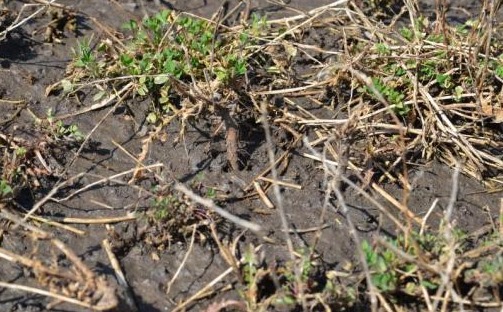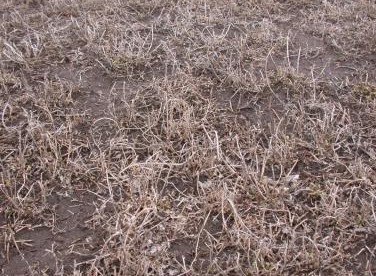By Joshua Michel
While row crops are generally the focus of attention this time of year, spring is a great time to scout for winter injury in alfalfa fields and assess stand health. This is especially true if stands did not have adequate snow cover or were covered by sheets of ice during the winter. Several other factors may contribute to alfalfa winter injury, including soil moisture, 4-inch soil temperatures, and other stresses like soil fertility, stubble height, as well as the age of the stand.

Winter Injury Observations:
Heaving. Although most of Iowa was dry throughout the fall, parts of eastern and northeast Iowa went into winter with more soil moisture than previous years. This may enhance the chance for frost-heave injury. Just as paved streets can heave and settle in the winter due to the winter freeze, so can alfalfa plants. This heaving action may be strong enough to snap taproots. Sometimes the alfalfa completely moves with the soil; in other situations, the alfalfa does not completely settle back down, especially when the taproots were snapped. When this happens, the crown is exposed above the soil surface. If this happens too early in winter, the exposed crown tissue will be killed by the cold winter temperatures. If this happens late enough in winter/spring, the exposed crown may still survive for another season if the cutting height is above the crown. However, the plant will likely winterkill next winter when the raised crown is exposed to the winter temperatures.
Cold temperature exposure and 4-inch soil temperatures. In some cases, the crown/upper taproot may not tolerate exposure to cold temperatures. Alfalfa tolerance to winter is complicated, as discussed in an earlier ICM News article, “Alfalfa Winter Survival - A Complicated Subject.” Four-inch soil temperatures across Iowa in winter are usually in the upper 20s to low 30s. These temperatures typically are of little threat to alfalfa crowns as long as we maintain adequate snow cover. Snow cover provides an insulation factor, which can protect from below zero air temperatures. A lack of snow cover during periods of frigid air temperatures can be very stressful for overwintering plants. A couple of very cold days in December and February caused 4-inch soil temperatures to drop down to as low as 13° F at some weather station locations across northern Iowa. It will likely become obvious as fields begin to green up, where the snow drifted and provided insulation compared to parts of a field that may not have been protected.

Soil moisture conditions. Much of the western part of the state experienced various degrees of drought throughout the past growing season and well into winter. Although drought conditions may weaken overall plant vigor, dry conditions can actually have a positive effect on alfalfa winter hardiness. Alfalfa grown in well-drained areas or soils with less soil moisture tend to be less prone to winter injury due to less difficulty in losing remaining plant moisture. So, while dry conditions may cause plant stress, they also can be helpful for plant dehydration.
It’s well known that alfalfa does not tolerate wet soils for very long, so some stand loss in low areas and hillside seeps that were saturated for any length of time may occur. Under normal fall conditions, adapted alfalfa varieties harden off in order to tolerate wintertime 4-inch soil temperatures of 15° F or less before damage to crown tissue may occur. However, if there’s excess soil moisture in the fall, the ability to harden off can be reduced. Additionally, as discussed earlier due to limited snow cover, some areas across northern Iowa saw soil temperatures drop down to 13° F. Field drainage and the duration of saturated roots play important roles in why some low areas are fine and some are not.
Alfalfa stubble height in fall. While this factor may not always seem to make a difference, it can play a role when we have limited snowfall throughout the winter. Fields that were cut short and late in the fall may not have adequate stubble height to collect and hold an insulating layer of snow. This could result in cold and damaging temperatures to alfalfa crowns.
Other stresses. Other stresses that could impact winter survival of alfalfa include: stand age, variety winter hardiness and disease resistance, soil pH, soil potassium level, soil drainage, and harvest schedule. In general, the older the stand, the more likely it is to winterkill. This is especially true for stands older than four years. Stands grown in soils with a pH of 6.8 or higher and optimum potassium levels are also less likely to winterkill. Lastly, allowing at least six weeks of growth in the fall before the first killing freeze allows plants to store carbohydrates needed for winter survival.
Managing alfalfa fields with winter injury
As fields begin to green-up and produce a few inches of new growth it will be much easier to assess stands for winter injury. Table 1 and Table 2 below can be used to help determine what type of action may be warranted in a field. Possible remedial actions could be doing some patch-work seeding, keeping the field for a first crop cutting and then rotating, or rotating fields entirely.
Table 1. Suggested plans of action based on observations and alfalfa field conditions.
| Observation | Condition | Action |
| At green-up | | |
| Large dead areas | | Plan to rotate. |
| Small dead areas | Some stand loss | Consider reseeding small areas. |
| Random injury of a few plants or very small areas | Some stand loss | Consider stand as a whole: - if it's too thin to keep - rotate
- If unsure -recheck in 2 weeks
|
| General plant health appears normal | Little to no damage observed | Recheck in 2 weeks to be sure |
| At 3-inch growth | | |
| Damaged areas larger; plant health deteriorating | Stand is getting worse | Is stand adequate? - No, rotate.
- Yes/maybe, recheck in 2 weeks.
|
| General plant health normal or improving | Little or no damage | Plan for normal harvest. |
| At 6-inch regrowth | | |
| Plant growth is far enough along for the stem-count evaluation method. | >55 stems per sq. ft. | Plan for 100% normal season yield. |
| 55-40 stems per sq. ft. | Expect 0 to 30% season yield reduction. |
| <40 stems per sq. ft. | Consider rotating unless grass mix is present; if so, fertilze with N to encourage the grass. |
Table 2. Recommended plant counts per square foot in either pure alfalfa or alfalfa-grass mix based on the age of the stand. Source: Modified from Table 2 in PM 1362 “Evaluating Hay and Pasture Stands for Winter Injury”
| Stand Age | Pure alfalfa | Alfalfa-grass mix |
| Seeding year | >20 plants in fall | >12 plants in fall |
| 1st production year | >12 plants in spring | >8 plants in spring |
| 2nd production year | >8 plants in spring | >6 plants in spring |
| 3rd production year | >5 plants in spring | >4 plants in spring |
| 4th production year+ | >4 plants in spring | >3 plants in spring |
Overwintering perennial forage grasses often survive better than winter hardy legumes. Orchardgrass and ryegrasses are more susceptible to winter injury than other perennial forage grasses. Visually evaluate grass regrowth and health of crown tissue when evaluating winter survival of pastures.
Reseeding in hayfields or pastures might be needed. It is not recommended to reseed alfalfa into stands that are two years or older due to the likelihood of autotoxicity. Overseeding or drilling grasses or red clover into thin or winter damaged stands ideally would be done before May 1. Seeding after mid-May increases the likelihood seeds will germinate but less frequent rainfall may allow the soil to dry out before the roots are deep enough to reach moist soil, killing the seedlings.
Below are some additional resources related to alfalfa winter injury and managing winter injury:
Source : iastate.edu